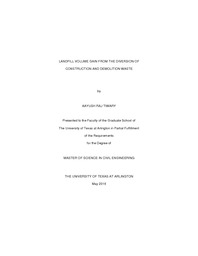
ATTENTION: The works hosted here are being migrated to a new repository that will consolidate resources, improve discoverability, and better show UTA's research impact on the global community. We will update authors as the migration progresses. Please see MavMatrix for more information.
Show simple item record
| dc.contributor.advisor | Hossain, Sahadat | |
| dc.creator | Tiwary, Aayush Raj | |
| dc.date.accessioned | 2016-01-27T21:58:37Z | |
| dc.date.available | 2016-01-27T21:58:37Z | |
| dc.date.created | 2015-12 | |
| dc.date.issued | 2015-12-09 | |
| dc.date.submitted | December 2015 | |
| dc.identifier.uri | http://hdl.handle.net/10106/25502 | |
| dc.description.abstract | Construction and Demolition (C&D) waste is one of the major components of the solid waste and is defined as a waste stream resulting from the construction, renovation and demolition of structures such as buildings, roads, and bridges. The amount of C&D waste has been in an upsurge with rapid growth in construction works and is expected to grow even more. As such, the effective waste management for C&D disposal has been a global issue owing to the increasing construction works worldwide. Although landfill disposal of C&D waste is not the preferred method of the C&D waste management, a significant portion of C&D waste is disposed in the landfills. Apart from the environmental and health risks, the landfill disposal of C&D waste also consumes considerable amount of landfill volume. Due to the high construction cost and scarcity of land, it is important to take possible measures to save landfill volumes. Hence, diversion of C&D waste from the main waste stream can substantially help in gaining more landfill volume. However, to estimate the possible volume gain from the diversion of the C&D waste, it is important to understand the properties of the C&D waste. Therefore, the objective of this study was to evaluate the properties of the C&D waste and estimate the possible landfill volume gain from the diversion of C&D waste.
For the current study, five construction and five demolition waste samples were collected from the City of Denton landfill in October 2015. Based on the manual sorting of the samples, the average composition for the C&D waste with equal proportion of construction waste and demolition waste (50% Construction and 50% demolition waste) was found to consist of 36.6% wood products, 18.3% Portland cement concrete, 10% asphalt concrete, 12% brick and tiles, 1.3% metals, 11% drywall & plaster, 5% cardboard, and 6% C&D debris fine. The unit weights of the collected samples were determined using the standard proctor method. For C&D waste with equal proportion of construction waste and demolition waste (50% Construction and 50% demolition waste), the unit weight was found to be 62.13 pcf (0.84 tons per cubic yard). The average moisture content of construction waste was determined to be 5.93% and 6.33% on wet weight and dry weight basis respectively. Whereas, the average moisture content for demolition waste was found to be 2.73 % and 2.81% on wet weight and dry weight basis respectively. The volatile solids content of construction waste was found to be 82.7% in average.
The landfill volume gain was estimated based on the average annual tonnage and unit weight from the current study. Based on the results, for a landfill with 20 acres area, 100 feet design height and 3H:1V side slope, approximately 1.25% of total landfill volume which is approximately equal to 0.61% of total lift height can be obtained per year by diverting 90% of the C&D waste from the landfill. | |
| dc.format.mimetype | application/pdf | |
| dc.language.iso | en_US | |
| dc.subject | Construction and demolition waste | |
| dc.subject | Landfill volume gain | |
| dc.title | LANDFILL VOLUME GAIN FROM THE DIVERSION OF CONSTRUCTION AND DEMOLITION WASTE | |
| dc.type | Thesis | |
| dc.date.updated | 2016-01-27T21:58:37Z | |
| thesis.degree.department | Civil Engineering | |
| thesis.degree.grantor | The University of Texas at Arlington | |
| thesis.degree.level | Masters | |
| thesis.degree.name | Master of Science in Civil Engineering | |
| dc.type.material | text | |
Files in this item
- Name:
- TIWARY-THESIS-2015.pdf
- Size:
- 2.085Mb
- Format:
- PDF
This item appears in the following Collection(s)
Show simple item record


